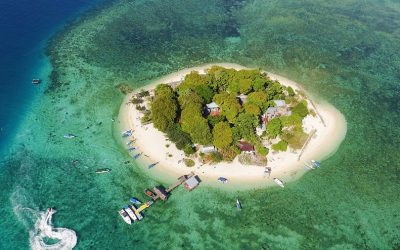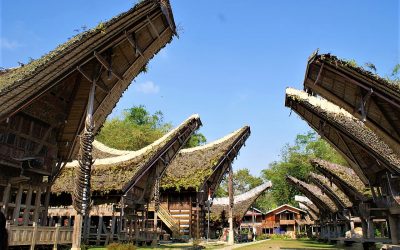Home / Batik Regions – Central Indonesia – Sulawesi Island – South Sulawesi / Ammatoa Indigenous Village
Cultural Destination
Embrace the spirit of the place!
Ammatoa Indigenous Village
Ammatoa Indigenous Village (Photo: CeritaFebrian)
Kajang community in Ammatoa Village (Photo: @educationtech)
Ammatoa Indigenous Village
As soon as you enter in this village you can really perceive the locals’ willingness to have you in their village. In fact you will find something which tells “Welcome to Ammatoa Indigenous Village”. This village is inhabited by the Kajang tribe, which is one of the oldest tribe existed in Indonesian archipelago. When exploring the village, if you notice, most houses have similar shape and follow the same direction. Kajang tribe is known for their local wisdom to communicate with nature. In addition, they have a typical traditional ceremony that is practised to reveal one’s lies. The villains and those whose lies are proven during the ceremony will be punished according to the custom. Black is the typical colour used by local villagers, as it is considered as the metaphor of truth and honesty. Do you want to experience another cultural sensation? Come here and feel the difference!
Cultural Tourism Destination
Ammatoa Indigenous Village
Tourist Attractions in South Sulawesi
Samalona Beach
If you are longing for a small getaway on an island with blue sea and white sand, this island
Tana Toraja National Heritage Site
One cannot miss the wonder of Kete Kesu Village in Tana Toraja. It is the homeland of
Bantimurung National Park
Have you ever thought if the Kingdom of Butterflies really exists in the world?
South Sulawesi
Batik Motifs
La Galigo
La Galigo is a literary work of the Buginese Epic that has 300 thousand epic lines. It is considered even
Lontara
The Lontara script itself is a typical ancient script of Bugis and Makassar communities. History records that
Tongkonan
Toraja’s traditional house is called Tongkonan. Tongkonan is a place for
Paqbarre Allo
The word “Barre” means round and “Allo” means the sunlight. This motif is interpreted as
Discover
Indonesian
Batik
Motifs
Gonggong Beruntun
This motif illustrates that a person should maintain a positive attitude and
Paqbarre Allo
The word “Barre” means round and “Allo” means the sunlight. This motif is interpreted as
Ake Patra
Ake is related to the divinity and the composition of the universe. It is a symbol of
Besurek Rafflesia
The term “Basurek” refers to a textile that contains letters or inscriptions
Karawo Pinang
Pinang refers to the Palm areca tree. This motif is considered as the original
Kasih Tak Sampai
‘Kasih Tak Sampai’ is an idiom in the Indonesian language which refers to
Kawung
The Kawung motif was created by Sultan Agung Hanyokrokusumo (1593 – 1645) as a symbolic gift for
Burung Bidadari
Bidadari birds are endemic birds in Halmahera. This motif represents an
Kuda Kupang
Horses symbolize wealth. It contains noble values of virtuous characters that bring
Leuit Sijimat
This motif reflects the daily activities of the Baduy tribe in Banten. The main ornaments of batik motif consist of:
Desa Na Tolu
The Desa Na Tolu characteristic pattern symbolizes the Batak philosophy of existence and
Wirasat
Wirasat or divine inspiration is a gift from God. This inspiration is symbolized by
Sekar Jati
Sekar means flower and Jati refers to teak trees that symbolizes a strong mental character that
Besurek Rembulan
This batik illustrates praise for God who created the wonderful universe
Daun Sirih
This motif illustrates betel leaves that are used by Lombok communities as traditional
Jupri Kembang Teh
Kembang Teh illustrates the tendrils of tea plants that grow in the highlands of
Kain Cual
Cual textile tradition has existed since the 17th century. The word “Cual” refers to
Bomba Mawar
This motif means sacred love for family, kingdom, and God; It also illustrates
Keluak Daun Pakis
The word “Keluak” is a Minang language which means twisted or tangled. The Motif of
Honai
The Honai is inspired by the traditional house of the Papuan community living in
Gamolan
This motif illustrates Gamolan, a bamboo musical instrument of Lampung that is
Enggang Dayak
Local people beliefs that hornbills are an incarnation of the Commander of the Birds. It has supernatural
Manguni Minahasa
Manguni is identified as the symbol of the Minahasa people. Manguni is known as a
Pinawetengan
The Pinawetengan Batik pattern was taken from a prehistoric inscription in
Bintik Tujuh
The Bintik Tujuh (Seven Dots) motif has 7 white spots and green color gradation as
Insang Ikan
Insang refers to the gills of the fish. This is a typical pattern of Malay ethnic who inhabits
Tongkonan
Toraja’s traditional house is called Tongkonan. Tongkonan is a place for
Tikar Natuna
The Tikar Natuna motif is adapted from the traditional making of pandanus mats in
Pattimura
Pattimura is the name of an Indonesian hero who fought against colonialism in
Raja Ampat
Raja Ampat motif represents the marine life at Raja Ampat archipelago in
Lok Baintan Floating Market
As you can imagine, the most authentic thing is that you can buy things and even
Tanah Liek
The word “Tanah Liek” refers to clay in Minang language. It is also known as
Prada Papua
The word “Prada” in the Javanese-Indonesian dialect means a batik textile that
Sero Tangga
The Sero Tangga illustrates an endearing feeling and sacrifices of a person to fulfil
Tifa Totobuang
The batik motifs illustrate Maluku’s traditional music instrument called
Sekomandi
Its philosophical meaning is the eternal union which refers to a saying “until death do us part”
Kaharingan
The Kaharingan or ‘tree of life’ based on the Dayak tribes’ belief system. This tree symbolizes
Gajah Way Kambas
The motif illustrates the Lampung’s natural reserve, the Way Kambas. it also symbolizes
Pati-Pati Pinehiku
It symbolizes the hierarchy in society and the social status of the Mekongga
Ukir Sentani
The Ukir motif is a batik motif that is inspired by various traditional Sentani wood carvings
Pucuk Rebung Riau
Pucuk Rebung symbolizes heart determination in achieving goals, good luck, and
Mahkota Siger
Siger is the crown of a noblewoman in ancient time. It is a symbol of femininity, strength, and
Ikan tambal
The word “Ikan” refers to fish. The philosophical meaning of Ikan Tambal means is
Daun Simpor
This motif is inspired by the Simpor plant (Dillenia Suffruticosa) which is a typical
Gentala Arasy
Built as high as 80 meters, the tower also highlights the historical side of
Bale Lumbu
This motif signifies the welfare of the ancient Sasak society. Bale also symbolizes the
Tangerang Herang
Tangerang Herang motif is a symbol of Tangerang city. The Tangerang Herang batik motif consists of
Tubo Kelapa
Coconut tree is a symbol of a good character and strong mentality. It illustrates the more success a person, the more
Tenun Bima
The motifs are adopted from Bima woven textile. This pattern has received a great
Dayak Taghol
Dayak Taghol has a distinctive style of four curved lines and small dots. This motif represents
Sido Mulyo
Sidomulyo is one of the classical motifs, which is specifically used for the bride’s costume in
Wakatobi
It symbolizes the coastal beauty of the Wakatobi island and the symbol of Patra symbolizes
Lontara
The Lontara script itself is a typical ancient script of Bugis and Makassar communities. History records that
Daun Lada Hitam
The black pepper motif represents the main commodity of Bangka Belitung
Kerawang Tegak Aceh
The Vertical Upright (Kerawang Tegak) Motif symbolizes a person who has a strong
Rumah Mamuju
the Batik motif illustrates the house of Mamuju King with the stairs, located on the left of the wooden stage house
Hiu Taliyasan
Indonesia is also home to the world’s largest fish, the whale shark (Rhincodon typus). Hiu Taliyasan refers to
Srimanganti
The name of the Srimanganti motif is derived from Palace’s hallway that connects to
Gumin Tambun
Based on Hindu mythology, this motif symbolizes lucks, abundant wealth, and
Durian Pecah
Broken Durian motifs depict the foundation of faith. The second half signifies the mastery of
Teguh Bersatu
This batik motif shows the strength of the people of Kupang. It also represents a sense of
Tengkawang Ampiek
With its many advantages, the Dayaks use this leaf in ritual ceremonies. This plant is a symbol of
Singayaksa
The Singayaksa motif comes from the name of a place where Sultan Hasanuddin used to
Lipaq Sabe
Lipaq Saqbe contains a simple geometric classical motif with various flower decorations. This textile is
Sandeq
Sandeq Boat is a symbol of the maritime importance of the West Sulawesi region. The greatness of
Buketan Bali
The Balinese bouquet (Buketan Bali) is a floral arrangement and the name is
Parang Seling
Parang Seling or “alternating daggers” is a royal batik motif. It is a feminine variant of
Salakanagara
Salakanagara batik motif illustrates the first kingdom in the Betawi land
Merak Ngeram
The hatching peacock motif has a very deep meaning which refers to the sacrifice and
Pala Salawaku
This motif illustrates the unique weapons of the Maluku region, namely
Tampuk Manggis Sasirangan
The motif illustrates the philosophy of the mangosteen fruit, which is
Gurdo Solo
Gurdo or garuda bird is the mount of the Indian god Vishnu. As the Sun Bird,
Angsa Duo
According to legend, the Angso duo batik motif is a pair of swans that are believed to have led Princess





